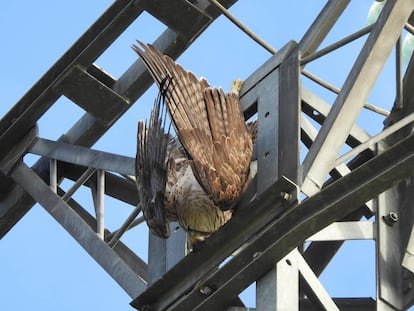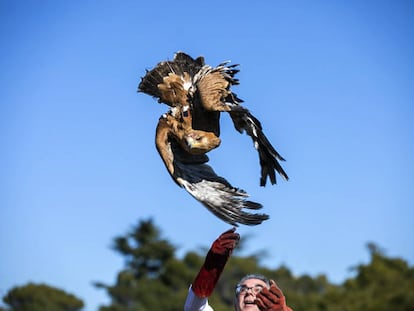Madrid to cull nearly 12,000 invasive parakeets threatening the city’s ecosystem
The plan is set to cost around €100,000, and is aimed at reducing the birds’ numbers, which have jumped 33% since 2016

Madrid City Hall announced on Monday a plan to hunt and cull the majority of the 12,000 monk parakeets in the Spanish capital, on the basis that they are a threat to safety and biodiversity. The local government, which is run by a coalition between the conservative Popular Party (PP) and center-right Ciudadanos (Citizens) with the support of far-right Vox, will also sterilize the eggs of this invasive species, which is aggressive and is affecting native birds such as sparrows.
We don’t know what could happen if we don’t manage to reduce the population
Santiago Soria Carreras, head of the Biodiversity Service at Madrid City Hall
The head of environment and mobility at City Hall, the PP’s Borja Carabante, announced the plan during a visit to the Casa de Campo, a sprawling public park west of the city that is one of the areas most affected by the bird species.
The plan is set to be carried out in the fall of next year, and will cost between €6 and €8 for each parakeet, around €100,000 in total.
The population of monk parakeets in Madrid has increased 33% since 2016. The small, bright-green birds, which are also known as the Quaker parrot, can live up to 20 years in captivity and reproduce rapidly, producing six to eight eggs a year. As well as making unpleasant screeching noises, the monk parakeets transmit diseases to other birds, consume their food and push out other species, explains Santiago Soria Carreras, the head of the Biodiversity Service at Madrid City Hall. According to Soria Carreras, falling nests have not caused any damage to passers-by yet, although the previous local government received 197 complaints about the birds from residents between January and August of this year.
Madrid City Hall received 197 complaints about the birds between January and August of this year
“It is an animal that adapts very well to conditions that are not its own. It has adapted because it is very intelligent. It also eats many things and takes advantage of any scrap of food or vegetable,” said Soria Carreras. The cold has not had any effect on the parakeets because their nests are very thick, even though the bird comes from the warm climate of the semi-tropical rainforest north of Argentina and south of Brazil. These nests can weigh up to 200 kilos, although they are usually between 40 and 50 kilos. “If [the nests] are made at a height of 15 to 20 meters, [the impact when they fall] is completely lethal,” added Carabante.
Carabante says the plan will be carried out in accordance with the animal welfare law, but it has yet to be finalized. The environmental head explained that not all of the monk parakeets in Madrid will be culled, as stipulated by the law, but says that a population of up to 600 birds “would cause minimal or acceptable” damage.
Most-affected: Carabanchel and Moncloa-Aravaca
According to a census conducted by Madrid City Hall, the areas most affected by the monk parakeets are Carabanchel (with around 2,300 birds, 20% of the total population in the capital) and Moncloa-Aravaca.“We don’t know why they concentrate in certain zones because their behavior in the urban environment is unknown, but the population is increasing and they could move districts,” said Soria Carreras.
In 2005, a thousand monk parakeets were documented in Madrid, which was considered “problematic because the population from this figure does not decrease by itself,” explained Soria Carreras, who added that the invasive species is also affecting other Spanish cities such as Barcelona, Málaga and Valencia.
The invasion of the monk parakeet dates back to the 1980s and 1990s, when the birds were sold as pets. In 2011, the Agriculture Ministry included the bird on the list of exotic tropical species, but to date, around 200,000 parakeets have arrived in Spain. “They end up in parks because the owners get tired of them and set them free, or the birds escape,” explained Soria Carreras.
“All animal control hurts, and I’m the first to be hurt, but we have to understand that it is for the greater good, which is protecting the flora and fauna of Guadarrama [national park], the species that should be there,” he added. “We don’t know what could happen if we don’t manage to reduce the population. But it’s certain that they will push out our fauna and the possibility of a nest causing a serious accident would be greater.”
English version by Melissa Kitson.









































